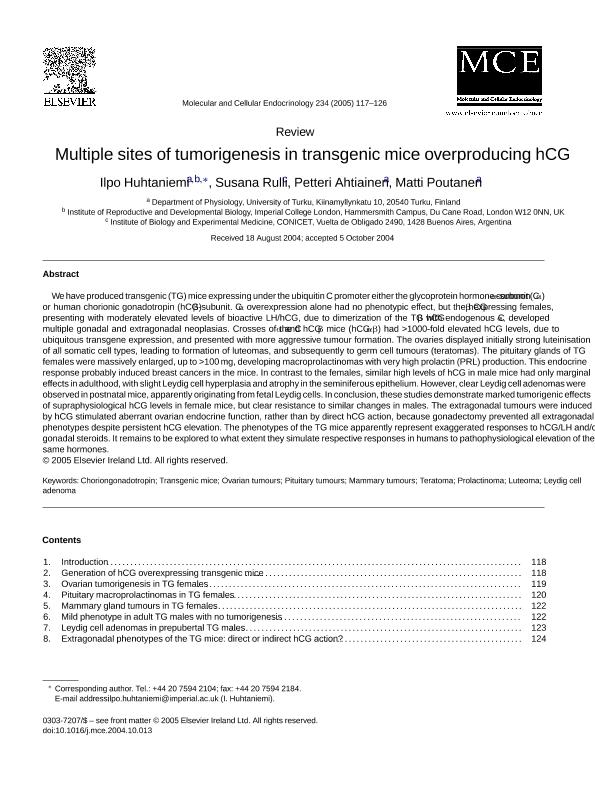Mostrar el registro sencillo del ítem
dc.contributor.author
Huhtaniemi, Ilpo
dc.contributor.author
Rulli, Susana Beatriz

dc.contributor.author
Petteri, Ahtiainen
dc.contributor.author
Poutanen, Matti
dc.date.available
2018-02-06T20:49:03Z
dc.date.issued
2005-02
dc.identifier.citation
Huhtaniemi, Ilpo; Rulli, Susana Beatriz; Petteri, Ahtiainen; Poutanen, Matti; Multiple sites of tumorigenesis in transgenic mice overproducing hCG; Elsevier Ireland; Molecular and Cellular Endocrinology; 234; 2-2005; 117-126
dc.identifier.issn
0303-7207
dc.identifier.uri
http://hdl.handle.net/11336/35894
dc.description.abstract
We have produced transgenic (TG) mice expressing under the ubiquitin C promoter either the glycoprotein hormone common alpha-subunit (C(alpha)) or human chorionic gonadotropin (hCG) beta-subunit. C(alpha) overexpression alone had no phenotypic effect, but the hCG(beta) expressing females, presenting with moderately elevated levels of bioactive LH/hCG, due to dimerization of the TG hCG(beta) with endogenous C(alpha), developed multiple gonadal and extragonadal neoplasias. Crosses of the C(alpha) and hCG(beta) mice (hCG(alpha)beta) had >1000-fold elevated hCG levels, due to ubiquitous transgene expression, and presented with more aggressive tumour formation. The ovaries displayed initially strong luteinisation of all somatic cell types, leading to formation of luteomas, and subsequently to germ cell tumours (teratomas). The pituitary glands of TG females were massively enlarged, up to >100 mg, developing macroprolactinomas with very high prolactin (PRL) production. This endocrine response probably induced breast cancers in the mice. In contrast to the females, similar high levels of hCG in male mice had only marginal effects in adulthood, with slight Leydig cell hyperplasia and atrophy in the seminiferous epithelium. However, clear Leydig cell adenomas were observed in postnatal mice, apparently originating from fetal Leydig cells. In conclusion, these studies demonstrate marked tumorigenic effects of supraphysiological hCG levels in female mice, but clear resistance to similar changes in males. The extragonadal tumours were induced by hCG stimulated aberrant ovarian endocrine function, rather than by direct hCG action, because gonadectomy prevented all extragonadal phenotypes despite persistent hCG elevation. The phenotypes of the TG mice apparently represent exaggerated responses to hCG/LH and/or gonadal steroids. It remains to be explored to what extent they simulate respective responses in humans to pathophysiological elevation of the same hormones.
dc.format
application/pdf
dc.language.iso
eng
dc.publisher
Elsevier Ireland

dc.rights
info:eu-repo/semantics/openAccess
dc.rights.uri
https://creativecommons.org/licenses/by-nc-sa/2.5/ar/
dc.subject
Choriongonadotrophin
dc.subject
Transgenic Mice
dc.subject
Ovarian Tumors
dc.subject
Pituitary Tumors
dc.subject.classification
Medicina Critica y de Emergencia

dc.subject.classification
Medicina Clínica

dc.subject.classification
CIENCIAS MÉDICAS Y DE LA SALUD

dc.title
Multiple sites of tumorigenesis in transgenic mice overproducing hCG
dc.type
info:eu-repo/semantics/article
dc.type
info:ar-repo/semantics/artículo
dc.type
info:eu-repo/semantics/publishedVersion
dc.date.updated
2017-12-28T13:40:22Z
dc.journal.volume
234
dc.journal.pagination
117-126
dc.journal.pais
Países Bajos

dc.description.fil
Fil: Huhtaniemi, Ilpo. University of Turku; Finlandia
dc.description.fil
Fil: Rulli, Susana Beatriz. Imperial College London; Reino Unido. Consejo Nacional de Investigaciones Científicas y Técnicas. Instituto de Biología y Medicina Experimental. Fundación de Instituto de Biología y Medicina Experimental. Instituto de Biología y Medicina Experimental; Argentina
dc.description.fil
Fil: Petteri, Ahtiainen. University of Turku; Finlandia
dc.description.fil
Fil: Poutanen, Matti. University of Turku; Finlandia
dc.journal.title
Molecular and Cellular Endocrinology

dc.relation.alternativeid
info:eu-repo/semantics/altIdentifier/doi/https://doi.org/10.1016/j.mce.2004.10.013
Archivos asociados
